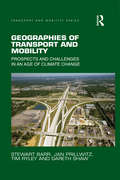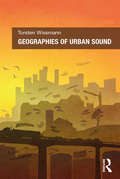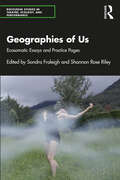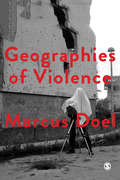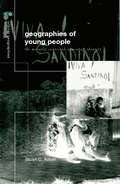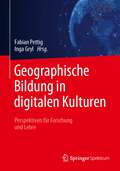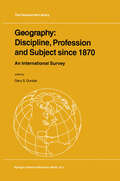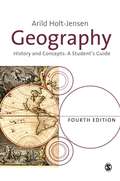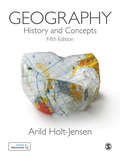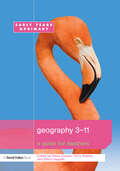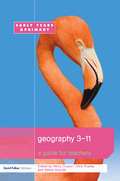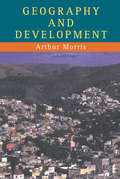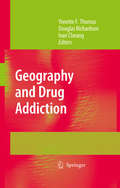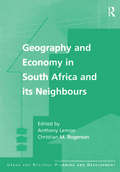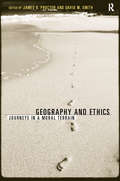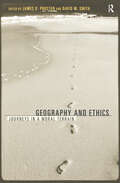- Table View
- List View
Geographies of Transport and Mobility: Prospects and Challenges in an Age of Climate Change (Transport and Mobility)
by Stewart Barr Jan Prillwitz Tim Ryley Gareth ShawGeographies of Transport and Mobility aims to provide a comprehensive and evidenced account of the intellectual and pragmatic challenges for personal mobility in the twenty-first century. In doing so, it argues that geographers have a key role to play in shaping academic and policy debates on how personal mobility can become more sustainable. The book is structured in three parts. Part I explores how personal mobility has evolved since the mid-nineteenth century, plotting the intricate relationship between new forms of mobile technology, urban planning and design and social practices. Part II examines how researchers study transport and mobility, and outlines the different intellectual trajectories of transport geography and geographies of mobilities. Part III then outlines and discusses the discourse of sustainable mobility that has emerged in recent years; the ways in which social, economic and environmental sustainability can be promoted through different strategies, focusing on behavioural change and urban design. Geographies of Transport and Mobility provides a unique perspective on personal mobility by demonstrating how the way we travel has developed through complex economic and social processes. It argues that this historical context is critical for considering how mobility in the twenty-first century can be more sustainable, not just environmentally, but also economically and socially. As such, it argues for a renewed focus on sustainable place making as a way to radically shift mobility practices. Geographies of Transport and Mobility is designed to appeal to advanced level undergraduate students and researchers in the fields of geography, anthropology, psychology, sociology and transport studies.
Geographies of Urban Sound
by Torsten WissmannTraffic, music, language and nature help to create unique soundscapes that are essential to the place-based character of each city. Taking into account both the urban soundscape and the impacts of sound on the urban dweller, this book examines sound not as a by-product of urban life, but as a fundamental part of the urban experience that is crucial to understanding the city´s sense of place. Illustrated by case studies from Europe and North America, these range from on-site measurements to the construction of audio tours for local tourism, from media analysis of popular culture audio drama to sound-identity and city branding, and from the classification of noise in city planning to a consideration of the complex relationship between sacred sound and the creation of a sense of place. Taking a social geographic perspective, the book focuses on the effects of sounds on the individual and how they influence the ways s/he engages the city as place, especially in their daily routines. In doing so, it uncovers the socio-scientific potential of sound in the urban environment, based on the understanding that sound cannot and must not be seen as detached from the urban landscape, but rather as a constituting element. Sound exists not only ’within the city’: it ’is’ the city.
Geographies of Urban Sound
by Torsten WissmannTraffic, music, language and nature help to create unique soundscapes that are essential to the place-based character of each city. Taking into account both the urban soundscape and the impacts of sound on the urban dweller, this book examines sound not as a by-product of urban life, but as a fundamental part of the urban experience that is crucial to understanding the city´s sense of place. Illustrated by case studies from Europe and North America, these range from on-site measurements to the construction of audio tours for local tourism, from media analysis of popular culture audio drama to sound-identity and city branding, and from the classification of noise in city planning to a consideration of the complex relationship between sacred sound and the creation of a sense of place. Taking a social geographic perspective, the book focuses on the effects of sounds on the individual and how they influence the ways s/he engages the city as place, especially in their daily routines. In doing so, it uncovers the socio-scientific potential of sound in the urban environment, based on the understanding that sound cannot and must not be seen as detached from the urban landscape, but rather as a constituting element. Sound exists not only ’within the city’: it ’is’ the city.
Geographies of Us: Ecosomatic Essays and Practice Pages (Routledge Studies in Theatre, Ecology, and Performance)
by Sondra Fraleigh Shannon Rose RileyGeographies of Us: Ecosomatic Essays and Practice Pages is the first edited collection in the field of ecosomatics.With a combination of essays and practice pages that provide a variety of scholarly, creative, and experience-based approaches for readers, the book brings together both established and emergent scholars and artists from many diverse backgrounds and covers work rooted in a dozen countries. The essays engage an array of crucial methodologies and critical/theoretical perspectives, including practice-based research in the arts, especially in performance and dance studies, critical theory, ecocriticism, Indigenous knowledges, material feminist critique, quantum field theory, and new phenomenologies. Practice pages are shorter chapters that provide readers a chance to engage creatively with the ideas presented across the collection. This book offers a multidisciplinary perspective that brings together work in performance as research, phenomenology, and dance/movement; this is one of its significant contributions to the area of ecosomatics.The book will be of interest to anyone curious about matters of embodiment, ecology, and the environment, especially artists and students of dance, performance, and somatic movement education who want to learn about ecosomatics and environmental activists who want to learn more about integrating creativity, the arts, and movement into their work.
Geographies of Us: Ecosomatic Essays and Practice Pages (Routledge Studies in Theatre, Ecology, and Performance)
Geographies of Us: Ecosomatic Essays and Practice Pages is the first edited collection in the field of ecosomatics.With a combination of essays and practice pages that provide a variety of scholarly, creative, and experience-based approaches for readers, the book brings together both established and emergent scholars and artists from many diverse backgrounds and covers work rooted in a dozen countries. The essays engage an array of crucial methodologies and critical/theoretical perspectives, including practice-based research in the arts, especially in performance and dance studies, critical theory, ecocriticism, Indigenous knowledges, material feminist critique, quantum field theory, and new phenomenologies. Practice pages are shorter chapters that provide readers a chance to engage creatively with the ideas presented across the collection. This book offers a multidisciplinary perspective that brings together work in performance as research, phenomenology, and dance/movement; this is one of its significant contributions to the area of ecosomatics.The book will be of interest to anyone curious about matters of embodiment, ecology, and the environment, especially artists and students of dance, performance, and somatic movement education who want to learn about ecosomatics and environmental activists who want to learn more about integrating creativity, the arts, and movement into their work.
Geographies of Violence: Killing Space, Killing Time (PDF)
by Marcus A DoelWe experience violence all our lives, from that very first scream of birth. It has been industrialized and domesticated. Our culture has not become totally accustomed to violence, but accustomed enough. Perhaps more than enough. Geographies of Violence is a critical human geography of the history of violence, from Ancient Rome and Enlightened wars through to natural disasters, animal slaughter, and genocide. Written with incredible insight and flair, this is a thought-provoking text for human geography students and researchers alike.
Geographies of Violence: Killing Space, Killing Time (Society and Space)
by Marcus A DoelWe experience violence all our lives, from that very first scream of birth. It has been industrialized and domesticated. Our culture has not become totally accustomed to violence, but accustomed enough. Perhaps more than enough. Geographies of Violence is a critical human geography of the history of violence, from Ancient Rome and Enlightened wars through to natural disasters, animal slaughter, and genocide. Written with incredible insight and flair, this is a thought-provoking text for human geography students and researchers alike.
The Geographies of Young People: The Morally Contested Spaces of Identity (Critical Geographies)
by Stuart C AitkenThe Geographies of Young People traces the changing scientific and societal notions of what it is to be a young person, and argues that there is a need to rethink how we view childhood spaces, child development and the politics of growing up.This book brings coherency to the growing field of children's geographies by arguing that although most of it does not prescribe solutions to the moral assault against young people, it nonetheless offers appropriate insights into difference and diversity, and how young people are constructed.Other books in the series:Culture/Place/Health (forthcoming)Seduction of Place (forthcoming)Celtic Geographies (forthcoming) TimespaceBodiesMind and Body SpacesChildren's GeographiesLeisure/Tourism GeographiesThinking SpaceGeopolitical TraditionsEmbodied GeographiesAnimal Spaces, Beastly PlacesCloset SpaceClubbingDe-centering SexualitiesEntanglements of Power.
The Geographies of Young People: The Morally Contested Spaces of Identity (Critical Geographies)
by Stuart C AitkenThe Geographies of Young People traces the changing scientific and societal notions of what it is to be a young person, and argues that there is a need to rethink how we view childhood spaces, child development and the politics of growing up.This book brings coherency to the growing field of children's geographies by arguing that although most of it does not prescribe solutions to the moral assault against young people, it nonetheless offers appropriate insights into difference and diversity, and how young people are constructed.Other books in the series:Culture/Place/Health (forthcoming)Seduction of Place (forthcoming)Celtic Geographies (forthcoming) TimespaceBodiesMind and Body SpacesChildren's GeographiesLeisure/Tourism GeographiesThinking SpaceGeopolitical TraditionsEmbodied GeographiesAnimal Spaces, Beastly PlacesCloset SpaceClubbingDe-centering SexualitiesEntanglements of Power.
Geographisch denken - nachhaltig handeln?!: Geographisches Wissen im Kontext der sozial-ökologischen Transformation (Sozial- und Kulturgeographie #60)
by Jonas BirkeDas 21. Jahrhundert ist durch multiple Herausforderungen geprägt, die es zu bewältigen gilt, wenn zukünftige Generationen ein Leben in Wohlstand auf dieser Erde führen wollen. Doch wie am Beispiel der Agenda 2030 deutlich wird, ist der Umsetzungsstand im Hinblick auf eine sozial-ökologische Transformation bisher unzureichend. Die Geographie kann hier einen enormen Beitrag leisten, der bisher in wissenschaftlichen, politischen und gesellschaftlichen Debatten kaum berücksichtigt wurde. Jonas Birke zeigt auf, wie geographisches Wissen durch eine holistische Sichtweise sowie eine starke Nähe zu alltäglichen Themen dazu beitragen kann, gesellschaftliches Handeln im Nachhaltigkeitskontext zu fördern und notwendige Veränderungen anzustoßen.
Geographische Bildung in digitalen Kulturen: Perspektiven für Forschung und Lehre
by Fabian Pettig Inga GrylWelche Herausforderungen für Forschungs- und Lehrkontexte bedingt die tiefgreifende Transformation alltäglicher Räume und Mensch-Umwelt-Verhältnisse in einer Kultur der Digitalität? Und wie lassen sich die hierin liegenden Potenziale für geographische Bildungsprozesse heben?Der vorliegende Band widmet sich diesen übergeordneten Fragestellungen und nimmt ernst, dass die Anforderungen an das Fach Geographie weit über technikfokussierte Ansätze, wie die Anwendung Geographischer Informationssysteme (GIS) im Klassenzimmer, hinausgehen. Ein Ziel sollte die Befähigung der Schüler*innen zum mündigen Medienhandeln in einer digital und medial durchdrungenen Welt sein. Phänomene wie hybride Räume, Smart Cities und Algorithmizität verlangen nach reflektierter und fachlicher Aufarbeitung digitaler Geographien als Bildungsinhalte, um ein geographisches Lernen mit, über und durch digitale Medien, sowie auch eine geographische Bildung in digitalen Medien zu ermöglichen.Dieser Aufgabe nimmt sich der Band aus zehn Perspektiven an, die die deutschsprachige wissenschaftliche Community der Geographiedidaktik gemeinschaftlich entwickelt hat. Sie loten Aufgaben, Handlungsfelder und Gelingensbedingungen geographischer Bildung in digitalen Kulturen aus. Drei Beitragskategorien bieten innerhalb der einzelnen Perspektiven Orientierung: Basiskommentare, die konzeptionelle Grundlagen darstellen; Forschungsbeiträge, die zur theoretischen wie auch empirischen Klärung beitragen und Good Practice-Beispiele, die Einblicke in Hochschul- und Schulpraxis gewähren. Die Perspektiven sind vielfach verwoben, stehen aber stellenweise auch in Spannung zueinander. Allen Beiträgen gemein ist, dass sie nach Wegen suchen, einen kritischen Umgang mit den Möglichkeiten und Herausforderungen des Digitalen wie auch eine emanzipierte Teilhabe in digitalen Kulturen zu etablieren.
Geography: An International Survey (GeoJournal Library #62)
by Gary S. DunbarThis book is a comprehensive treatment of the professionalization and institutionalization of the academic discipline of geography in Europe and North America, with emphasis on the 20th century and the last quarter of the 19th. No other book has ever attempted coverage of this sort. It is relevant to geographers, practitioners of the social and earth sciences, and historians of science and education.
Geography: History and Concepts (PDF)
by Arild Holt-JensenNow in a fourth edition, this standard student reference has been totally revised and updated. It remains the definitive introduction to the history, philosophy, and methodology of human geography; now including a detailed explanation of key ideas in human geography's post-modernist and post-structuralist 'turns'. The book is organized into six sections: What is Geography?: an introduction to the discipline, and a discussion of its organization and basic research approaches, informed by the question 'what difference does it make to think geographically?' Foundations of Geography: an examination of geography from Antiquity to the 1950s, with a special focus on human/environment relation. Geography 1950-1980: a critical review of the development of geography as a spatial science. Paradigms and Revolutions: an analysis of paradigm shifts in geography, introducing students to key debates in the philosophy of science. Positivism and its Critics: a detailed discussion of positivism, critical theory, humanistic geography, behavioural geography, and structuralism. New Trends and Ideas developing critical responses: structuration theory, realism, post-structuralism, post-modernism, feminism and actor-network theory. This text explores complex ideas in an intelligible and accessible style. Illustrated throughout with research examples and explanations in text boxes, questions for discussion at the end of each chapter and a concept glossary, this is the essential student companion to the discipline.
Geography: History and Concepts
by Arild Holt-JensenNow in a fourth edition, this standard student reference has been totally revised and updated. It remains the definitive introduction to the history, philosophy, and methodology of human geography; now including a detailed explanation of key ideas in human geography's post-modernist and post-structuralist 'turns'. The book is organized into six sections: What is Geography?: an introduction to the discipline, and a discussion of its organization and basic research approaches, informed by the question 'what difference does it make to think geographically?' Foundations of Geography: an examination of geography from Antiquity to the 1950s, with a special focus on human/environment relation. Geography 1950-1980: a critical review of the development of geography as a spatial science. Paradigms and Revolutions: an analysis of paradigm shifts in geography, introducing students to key debates in the philosophy of science. Positivism and its Critics: a detailed discussion of positivism, critical theory, humanistic geography, behavioural geography, and structuralism. New Trends and Ideas developing critical responses: structuration theory, realism, post-structuralism, post-modernism, feminism and actor-network theory. This text explores complex ideas in an intelligible and accessible style. Illustrated throughout with research examples and explanations in text boxes, questions for discussion at the end of each chapter and a concept glossary, this is the essential student companion to the discipline.
Geography: History and Concepts
by Arild Holt-JensenAn accessible, definitive student introduction to geographical thought, this book takes a unique approach that encompasses environmental, historical and social perspectives. Now in its fifth edition, it includes new case studies, and revisions and updates throughout, with additional chapters expanding coverage of global subjects, poststructuralism, and the future of geography. This text explores complex ideas in an intelligible and accessible style. Illustrated throughout with research examples and explanations in text boxes, questions for discussion at the end of each chapter and a concept glossary, this is the essential student companion to the discipline.
Geography: History and Concepts
by Arild Holt-JensenAn accessible, definitive student introduction to geographical thought, this book takes a unique approach that encompasses environmental, historical and social perspectives. Now in its fifth edition, it includes new case studies, and revisions and updates throughout, with additional chapters expanding coverage of global subjects, poststructuralism, and the future of geography. This text explores complex ideas in an intelligible and accessible style. Illustrated throughout with research examples and explanations in text boxes, questions for discussion at the end of each chapter and a concept glossary, this is the essential student companion to the discipline.
Geography 3-11: A Guide for Teachers
by Hilary CooperThe advent of the National Primary Strategy has produced a welcome reminder to teachers of the importance of geography within the primary curriculum. This book aims to encourage this renewed awareness and to support teachers in teaching primary geography in different and exciting ways. It will show that children have an entitlement to learn about geography and this can be achieved in a lively, creative fashion uplifting for both teachers and children. It covers: planning for and assessing progression in learning inclusion ICT and drama indoors, outdoors and beyond. Written in association with the Geographical Association, this book will help both trainee and experienced teachers to integrate geography as an essential part of the primary curriculum.
Geography 3-11: A Guide for Teachers
by Hilary CooperThe advent of the National Primary Strategy has produced a welcome reminder to teachers of the importance of geography within the primary curriculum. This book aims to encourage this renewed awareness and to support teachers in teaching primary geography in different and exciting ways. It will show that children have an entitlement to learn about geography and this can be achieved in a lively, creative fashion uplifting for both teachers and children. It covers: planning for and assessing progression in learning inclusion ICT and drama indoors, outdoors and beyond. Written in association with the Geographical Association, this book will help both trainee and experienced teachers to integrate geography as an essential part of the primary curriculum.
Geography And Development
by Arthur MorrisFirst published in 1998. Routledge is an imprint of Taylor & Francis, an informa company.
Geography And Development
by Arthur MorrisFirst published in 1998. Routledge is an imprint of Taylor & Francis, an informa company.
Geography and Drug Addiction
by Yonette F. Thomas Douglas Richardson Ivan CheungMaking Connections: Geography and Drug Addiction Geography involves making connections – connections in our world among people and places, cultures, human activities, and natural processes. It involves understa- ing the relationships and ‘connections’ between seemingly disparate or unrelated ideas and between what is and what might be. Geography also involves connecting with people. When I rst encountered an extraordinarily vibrant, intelligent, and socially engaged scientist at a private d- ner several years ago, I was immediately captivated by the intensity of her passion to understand how and why people become addicted to drugs, and what could be done to treat or prevent drug addiction. Fortunately, she was willing to think beyond the bounds of her own discipline in her search for answers. Our conversation that evening, which began with her research on fundamental biochemical processes of drug addiction in the human body, evolved inevitably to an exploration of the ways in which research on the geographical context of drug addiction might contribute to the better understanding of etiology of addiction, its diffusion, its interaction with geographically variable environmental, social, and economic factors, and the strategies for its treatment and prevention. This fascinating woman, I soon learned, was Nora Volkow, the Director of the National Institute on Drug Abuse as well as the granddaughter of Leon Trotsky.
Geography and Economy in South Africa and its Neighbours (Urban and Regional Planning and Development Series)
by Christian M. RogersonThe dismantling of the apartheid regime in South Africa caused massive transformation in both geographical and economic terms, not only in this country but also in the region as a whole. As the post-apartheid government enters its second term, this captivating volume assesses its progress in unravelling the geography of apartheid, both in South Africa itself and in its relationships with other countries in Southern Africa and Africa. It also considers the ways in which South Africa, now that it is no longer a pariah state, has begun to position itself within the current global economy. Examining South Africa’s land and agriculture, mining and minerals, manufacturing, tourism, corporate finance, the labour market and transport, the volume discusses the challenges of balancing growth and redistribution, the extent and nature of progress, change and relationships within the regional and global economy. A compelling investigation into the economics of South Africa's neighbouring states in relation to their natural resources, colonialism and inter-relationships with themselves and with South Africa leads to a focus on the region as a whole and its relations with the global economy.
Geography and Economy in South Africa and its Neighbours (Urban and Regional Planning and Development Series)
by Christian M. RogersonThe dismantling of the apartheid regime in South Africa caused massive transformation in both geographical and economic terms, not only in this country but also in the region as a whole. As the post-apartheid government enters its second term, this captivating volume assesses its progress in unravelling the geography of apartheid, both in South Africa itself and in its relationships with other countries in Southern Africa and Africa. It also considers the ways in which South Africa, now that it is no longer a pariah state, has begun to position itself within the current global economy. Examining South Africa’s land and agriculture, mining and minerals, manufacturing, tourism, corporate finance, the labour market and transport, the volume discusses the challenges of balancing growth and redistribution, the extent and nature of progress, change and relationships within the regional and global economy. A compelling investigation into the economics of South Africa's neighbouring states in relation to their natural resources, colonialism and inter-relationships with themselves and with South Africa leads to a focus on the region as a whole and its relations with the global economy.
Geography and Ethics: Journeys in a Moral Terrain
by James D. Proctor David M. SmithThis book represents a landmark exploration of the common terrain of geography and ethics. Drawing together specially commissioned contributions from distinguished geographers across the UK, North America and Australasia, the place of geography in ethics and of ethics in geography is examined through wide-ranging, thematic chapters.Geography and Ethics is divided into four sections for discussion and exploration of ideas: Ethics and Space; Ethics and Place; Ethics and Nature and Ethics and knowledge, all of which point to the rich interplay between geography and moral philosophy or ethics.
Geography and Ethics: Journeys in a Moral Terrain
by James D. Proctor David M. SmithThis book represents a landmark exploration of the common terrain of geography and ethics. Drawing together specially commissioned contributions from distinguished geographers across the UK, North America and Australasia, the place of geography in ethics and of ethics in geography is examined through wide-ranging, thematic chapters.Geography and Ethics is divided into four sections for discussion and exploration of ideas: Ethics and Space; Ethics and Place; Ethics and Nature and Ethics and knowledge, all of which point to the rich interplay between geography and moral philosophy or ethics.
